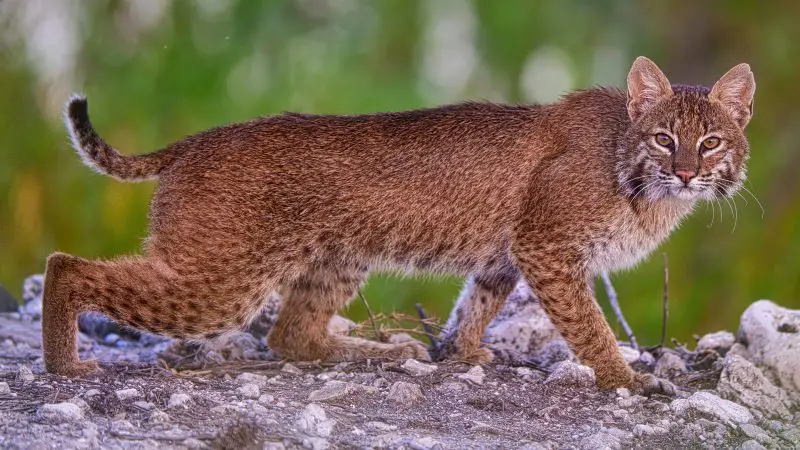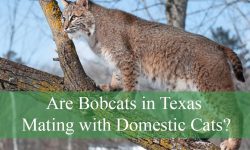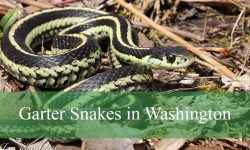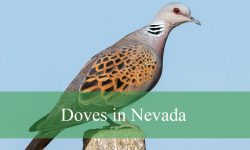Florida’s diverse landscape—from the Everglades’ watery maze to pine forests, scrublands, and coastal hammocks—hosts an elusive and adaptable predator: the bobcat (Lynx rufus floridanus). While most people associate Florida’s wild cats with the iconic Florida Panther, bobcats are far more common and widespread.
These solitary hunters thrive from remote swamps to suburban backyards, quietly shaping the ecosystem around them. Despite their abundance, many Floridians know little about how unique their bobcats are. This article dives deep into the hidden facts, habits, and ecological secrets of Florida’s bobcats, uncovering just how extraordinary these cats truly are.
The Florida Bobcat

Physical Description
The Florida bobcat is smaller than the Florida Panther but no less fierce. Adults typically weigh between 13 and 30 pounds, with a length of 28 to 50 inches and a shoulder height around 20 inches. Compact, muscular bodies give them the strength to leap over six feet vertically and pounce with precision.
Their short “bobbed” tails, which measure less than seven inches, give the species its name. The coat ranges from grayish to reddish-brown with dark spots and stripes, helping them blend perfectly with palmettos, pine needles, and forest shadows. On the back of their black-tipped ears, a distinctive white patch serves as a visual cue for communication between mother and kitten.
Behavior and Nature
Bobcats are crepuscular, meaning they are most active during twilight hours—just before sunrise and after sunset. Their sharp eyesight, excellent hearing, and padded paws make them expert ambush hunters. Despite their solitary lives, they communicate through scent marking, vocalizations, and body language.
These cats are the silent rulers of many Florida habitats, maintaining balance by keeping small mammal populations in check.
Habitat and Range in Florida
Where They Live
Bobcats are one of the few predators that thrive in nearly every Florida ecosystem. They inhabit hardwood forests, cypress swamps, pine flatwoods, mangroves, and even suburban green spaces. From the sandy uplands of central Florida to the wetlands of the Everglades, bobcats are everywhere prey and shelter are available.
Their dens are usually hidden in hollow logs, dense palmetto thickets, or abandoned burrows. Because they can live close to humans without being seen, bobcats often go unnoticed even in populated areas.
Urban Adaptation
As Florida’s human population grows, bobcats are learning to coexist with development. They use greenbelts, golf courses, drainage canals, and forest patches as corridors to move safely between hunting zones. It’s not uncommon for suburban residents to catch a glimpse of a bobcat prowling near ponds or open fields at dawn.
Their adaptability is a testament to how well they adjust to environmental pressures while avoiding direct conflict with humans.
Silent Territory Keepers
Territorial Behavior
Bobcats are solitary by nature and fiercely territorial. A single male’s territory can cover up to 12 square miles, overlapping with several females’ smaller ranges. They mark their boundaries using scent glands on their cheeks and paws, as well as through scratching trees and leaving scat in prominent spots.
They patrol their territories regularly, often using the same trails and resting sites repeatedly. Despite being solitary, they recognize neighboring individuals through scent and avoid unnecessary confrontations.
Stealth and Movement
Their quiet, calculated movements are what make them so effective as hunters. Padded paws allow bobcats to stalk prey almost silently. In Florida’s dense vegetation, this ability is crucial—they can creep within a few feet of their target before launching a sudden, powerful pounce.
Even in urban areas, bobcats time their movements to avoid human activity, maintaining their secretive presence in a world increasingly shaped by people.
Diet Diversity and Opportunistic Hunting
What Bobcats Eat
Bobcats are highly adaptable carnivores. Their diet varies depending on habitat but typically includes rabbits, rats, mice, squirrels, opossums, and birds. In wetland regions, they may eat wading birds, amphibians, and even small fish.
They prefer to ambush their prey rather than chase it. Once a bobcat spots movement, it crouches low, waits patiently, and strikes with lightning speed. This ambush style allows them to conserve energy while ensuring successful kills.
Feeding Habits
Florida bobcats sometimes cache leftover prey by covering it with leaves or grass, returning later when other food sources are scarce. This behavior shows foresight and adaptability—traits not always associated with mid-sized predators.
Their diverse diet also allows them to thrive in environments where other carnivores might struggle, such as suburban zones with fewer large prey animals.
Reproduction and Life Cycle
Breeding Season
In Florida, the breeding season extends longer than in northern states, typically from late winter through early summer. The mild climate and abundant food allow females to reproduce nearly year-round.
After a gestation period of about 60 days, females give birth to one to four kittens in hidden dens. These dens are usually located in hollow trees, dense brush, or rock crevices that provide safety from predators.
Raising the Young
Kittens are born blind and rely entirely on their mothers for warmth and food. Within two months, they begin exploring their surroundings under her supervision. The mother teaches them hunting techniques—stalking, pouncing, and caching food—before they disperse to establish their own territories around one year old.
Most Florida bobcats live 10 to 14 years in the wild, although road accidents and habitat loss shorten many lives. In captivity, some individuals live beyond 20 years.
Behavior and Human Interaction
Shy but Resilient
Bobcats are naturally wary of humans and will retreat when approached. They rarely pose any danger to people. However, they are increasingly being seen in suburban areas as natural spaces shrink.
In neighborhoods bordering forests or wetlands, bobcats may be drawn by abundant prey such as rabbits, rats, and even domestic chickens. Despite occasional conflicts, they play an important role by controlling pest populations.
Coexisting with Humans
Bobcats generally pose little threat, but small pets like cats or small dogs should be kept indoors at night. Secure garbage cans and avoid leaving pet food outdoors, as these attract potential prey that bobcats might follow.
Their presence should be viewed positively—it indicates a balanced, healthy ecosystem capable of supporting mid-level predators.
Camouflage and Color Variations
The Art of Disguise
Florida bobcats are masters of camouflage. Their mottled fur pattern helps them disappear into the landscape whether in swamps, woodlands, or suburban thickets. Even when they move, their smooth, fluid gait blends seamlessly with background shadows.
The white patches on their ears help kittens follow their mothers through dense vegetation, while the black tail tip acts as a distraction signal to potential predators.
Melanistic Bobcats
Rarely, all-black or melanistic bobcats have been spotted in southern Florida. These individuals possess extra pigmentation that may provide advantages in shaded forests or at night. While rare, their existence showcases the genetic diversity within Florida’s bobcat population.
The Bobcat’s Role in Florida’s Ecosystem
Natural Population Control
Bobcats are vital to Florida’s food web. As mid-level predators, they help regulate populations of small mammals like rabbits and rodents, preventing overgrazing and agricultural damage.
Their hunting patterns also indirectly support plant diversity by keeping herbivore populations in check. In areas where larger predators like the Florida Panther are absent, bobcats assume the role of top carnivore.
Ecosystem Indicators
Because they require stable prey populations and sufficient habitat cover, bobcats are excellent indicators of ecosystem health. Their presence signifies a balanced environment. When bobcat numbers decline, it often suggests habitat degradation or human encroachment.
Threats and Conservation
Major Threats
While bobcats are not endangered, they face increasing risks from habitat fragmentation, vehicle collisions, and disease. Expanding development reduces their territory and forces them into smaller, disconnected patches of habitat.
Exposure to rodenticides and pesticides through prey species can poison bobcats indirectly. In addition, diseases such as feline leukemia, transmitted by domestic cats, threaten wild populations in areas where the two species overlap.
Conservation Efforts
Wildlife corridors and habitat preservation are essential for their survival. Efforts to maintain green spaces, restore wetlands, and reduce pesticide use directly benefit bobcat populations. Education and coexistence programs also help dispel myths that lead to unnecessary fear or killing of these wild cats.
Myths and Misunderstandings
Common Misconceptions
Many people mistake bobcats for the larger Florida Panther, but bobcats are much smaller and have short tails. Another myth suggests that bobcats are dangerous to humans, but they are in fact shy and avoid confrontation.
Others believe bobcats can only survive deep in the wilderness. In reality, they are remarkably adaptable, often living just beyond neighborhoods, silently controlling rodent and rabbit populations.
Understanding these truths fosters coexistence and helps preserve Florida’s delicate ecological balance.
Tips for Living Alongside Bobcats
Observe and Protect
If you’re lucky enough to spot a bobcat, watch from a distance. They are most active at dawn and dusk, especially near wooded edges or open fields.
Keep small pets indoors after dark, and secure chickens or ducks in sturdy enclosures. Maintain vegetation and natural corridors so bobcats and other wildlife can travel safely.
Be a Responsible Neighbor
Avoid feeding wildlife or leaving out attractants. Drive carefully in rural or wooded areas, especially during low-light hours when bobcats are on the move. Appreciating and protecting these animals ensures their continued survival alongside human communities.
Conclusion
Bobcats are one of Florida’s most adaptable and important predators. They embody the wild spirit of the state’s natural landscapes—graceful, silent, and perfectly evolved for survival. Their intelligence, camouflage, and hunting skill allow them to thrive in a rapidly changing world.
Understanding the hidden lives of Florida’s bobcats deepens our appreciation for the fragile yet resilient ecosystems they inhabit. They remind us that even in the shadow of human expansion, wild nature endures.
The next time you glimpse a spotted shape slipping through palmettos or catch golden eyes reflecting in the twilight, remember: you’re witnessing one of Florida’s true survivors—the untamed and unforgettable bobcat.






